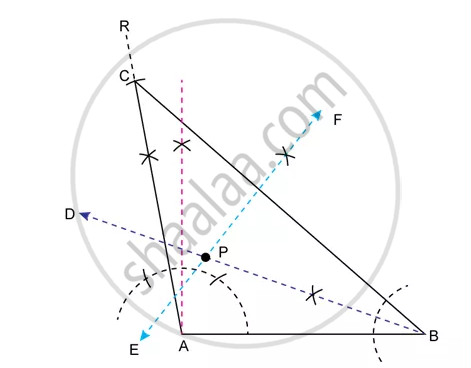Advertisements
Advertisements
प्रश्न
Constuct a triangle ABC with AB = 5.5 cm, AC = 6 cm and ∠BAC = 105°. Hence:
- Construct the locus of point equdistant from BA and BC.
- Construct the locus of points equidistant from B and C.
- Mark the point which satisfies the above two loci as P. Measure and write the length of PC.
उत्तर
Steps of construction:
- Draw AB = 5.5 cm.
- Construct ∠BAR = 105°.
- With centre A and radius 6 cm, cut off arc on AR at C.
- Join BC. ABC is the required triangle.
- Draw angle bisector BD of ∠ABC, which is the locus of points equidistant from BA and BC.
- Draw perpendicular bisector EF of BC, which is the loucs of point equidistant from B and C.
- BD and EF intersect each other at point P. Thus, P satisfies the above two loci. By measurement, PC = 4.8 cm.

APPEARS IN
संबंधित प्रश्न
Construct a regular hexagon of side 5 cm. Hence construct all its lines of symmetry and name them.
Construct a ΔABC with BC = 6.5 cm, AB = 5.5 cm, AC = 5 cm. Construct the incircle of the triangle. Measure and record the radius of the incircle.
Construct a triangle ABC in which base BC = 6 cm, AB = 5.5 cm and ∠ABC = 120°.
Construct a circle circumscribing the triangle ABC.
Draw a cyclic quadrilateral ABCD so that D is equidistant from B and C.
Using ruler and compasses only,
- Construct a triangle ABC with the following data :
Base AB = 6 cm, BC = 6.2 cm and ∠CAB = 60°. - In the same diagram, draw a circle which passes through the points A, B and C and mark its center O.
- Draw a perpendicular from O to AB which meets AB in D.
- Prove that : AD = BD.
Perpendicular bisectors of the sides AB and AC of a triangle ABC meet at O.
- What do you call the point O?
- What is the relation between the distances OA, OB and OC?
- Does the perpendicular bisector of BC pass through O?
Draw line segments OA = 4.5 cm, OB = 3.2 cm such that ∠ AOB = 45°. Construct a circle touching OA at A and passing through B.
Perpendicular bisectors of the sides AB and AC of a triangle ABC meet at O.
Does the perpendicular bisector of BC pass through O?
Construct an isosceles triangle ABC such that AB = 6 cm, BC = AC = 4 cm. Bisect ∠C internally and mark a point P on this bisector such that CP = 5 cm. Find the points Q and R which are 5 cm from P and also 5 cm from the line AB.
Using ruler and compass only, construct a triangle ABC such that AB = 5 cm, ABC = 75°, and the radius of the circumcircle of triangle ABC is 3.5 cm. On the same diagram, construct a circle, touching AB at its middle point and also touching the side AC.
Construct a Δ ABC with BC = 6.5 cm, AB = 5.5 cm, AC = 5 cm. Construct the incircle of the triangle. Measure and record the radius of the incircle.
